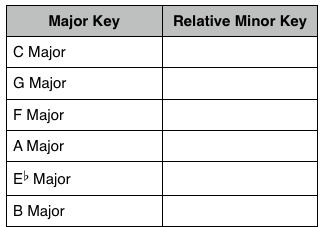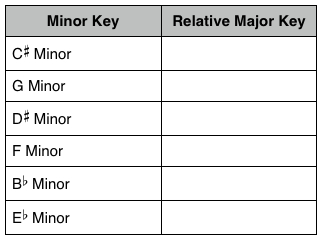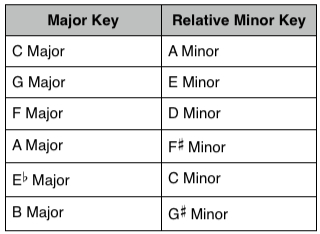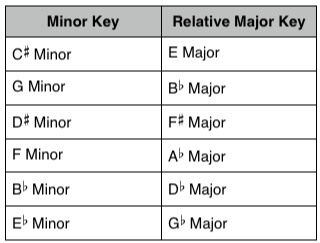In this guitar lesson we’re going to talk a little bit about relative keys. Learning the concept of them is helpful for rock guitar because it helps you with selecting scales to solo over various chord progressions.
Before you start with this lesson, it’s very important that you’ve laid a foundation. So please make sure that you’ve done all the exercises in the following two lessons…
Once you’ve filled out the tables from those lessons, then the next thing you need to do is read this lesson…
All done? Good stuff! You’re now ready to get started with this lesson…
Comparing The Major And Natural Minor Scales
Please take some time to look at the tables you filled out for the major scales and natural minor scales. If you look closely at them, then you’ll notice something very important…
For every major scale there is a natural minor scale that shares exactly the same notes.
Let’s take a look at an example. Below is the D Major scale and the B Natural Minor scale written out in standard notation. Don’t panic if you don’t read music, because I’ve written the note names above the notation. 🙂
D Major Scale:

B Natural Minor Scale:

If you look closely at the music above, you will probably notice the following things…
- The D Major scale uses the same notes as the B Natural Minor scale.
- Both scales use the same key signature (2 sharps).
Because these scales use the same key signature, they are called relative keys. In other words…
- D Major is the relative major of B Minor.
- B Minor is the relative minor of D Major.
An Easy Way Of Working Out Relative Keys
While it would be very diligent of you to learn all the relative keys by rote memorization, I don’t think it’s necessary unless you want to read standard notation very fluently. For this reason, what we’re going to do is look at a quick-and-easy way of working out relative keys. Let’s get started by looking at the notes of the D Major Scale again…
D Major Scale: Notes and Scale Degrees

If you look at the arrows I’ve drawn be low the table, you’ll notice that the notes B and D are three half-steps apart. This is really good to know because it means…
- To find the relative minor of a major scale, find the note that is three half-steps lower.
- To find the relative major of a minor scale, find the note that is three half-steps higher.
It’s quite common for guitarists to get these rules mixed up. So probably the best way to remember them is by memorizing the following diagram. This gives you a visual way of remembering the rules, and most of my students find it very helpful.
![]()
Work Out These Relative Keys
Please work out the relative minor keys of the following major keys…

Now work out the relative major keys of the following minor keys…

I’ll be giving you the answers at the end of this lesson. But please make sure you work these out now before reading any further. You’ll learn a lot more that way. 🙂
A Practical Use For Understanding Relative Keys
As I mentioned at the beginning of the lesson, understanding the concept of relative keys is useful when it comes time to solo over chord progressions. To help illustrate this, let’s take a look at the following chord progression…

If you have a basic understanding of major scale harmonization, then you’ll recognize that this progression makes use of the diatonic triads of the C Major scale. This means that we could solo over the entire progression using the C Major scale.
Now, here’s a question for you. What would be another scale you could use to solo over the progression?
If you’re not sure, then you might want to think about what the relative minor of C Major is. From what we talked about earlier, we know that the relative minor of C Major is A Minor. Knowing this is handy because it opens you up to scale choices that you might not have considered.
For Example: You might try using the following scales over the progression…
- A Natural Minor scale. Because this scale uses exactly the same notes as the C Major scale, then it’s really just the same scale. But if we mentally think of it as A Natural Minor rather than C Major, then this can influence the notes that we decide to emphasize when we solo.
- A Minor Pentatonic scale.
- A Minor Blues scale.
So how do you know if the scales we’ve just listed will work over the progression. The best way is to try using them. If you like how a scale sounds over the progression, then it’s a good choice! 🙂
The Answers To The Earlier Questions
I’m assuming here that you took the time to complete the tables from earlier on in the lesson. Well done—by doing the work you’re being active in your learning. This will definitely help you learn the material a lot more thoroughly than those lazy bums who just read this lesson. 🙂
Here are the answers so that you can double-check what your worked out. If you made any mistakes, then see if you can figure out where you went wrong.


A Few Last Words
I hope you found this lesson helpful. Don’t forget to record the chord progression we looked at and try those different scales over it. You’ll find it a lot of fun, and it’s also a great way to use the theory in a practical setting.
Have fun!
Return To: Guitar Music Theory Lessons